Seeing / Being Seen: LGBTQIA+ Writers on LGBTQIA+ Fiber Artists: Winter 2023 SDJ, Out Now!
December 27, 2023
Surface Design Association is excited to announce Seeing / Being Seen: LGBTQIA+ Writers on LGBTQIA+ Fiber Artists, our Winter 2023 edition of Surface Design Journal. Led by Guest Editor, Rebekah Frank, this special edition of the SDJ focuses on LGBTQIA+ writers exploring LGBTQIA+ artists, highlighting the complexity of intersectional identity and how it informs creative practices in fiber at a time when LGBTQIA+ rights are increasingly under attack.
“I hope that this collection of articles, essays and interviews demonstrates that to know someone who identifies as LGBTQIA+ is to know just one thing about them. The essentializing of someone’s identity is too easily used as an excuse to minimize, ostracize and de-humanize each other, ignoring all the possible points of connection, the most important being our shared humanity. This compilation of essays, interviews and articles by LGBTQIA+ writers about LGBTQIA+ textile artists offers an invitation to see and be seen, in all our complexity.” – Rebekah Frank, Guest Editor

Here’s a preview of what you’ll discover:
In the Realm of Lost Senses: The Embroidered Tapestries of Jagdeep Raina by Nicole Archer: “Jagdeep Raina’s densely embroidered tapestries are intricate material meditations on intimacy and the feelings of entanglement that transform the unbearable weight of waiting for intensely craved forms of contact into something not only manageable, but capable of liberating us from the logics of dispossession that wear down our senses of hope and agency”

Jagdeep Raina, Paradise Lost, 2019. Embroidered tapestry with Punjabi phulkari border on muslin, 18 x 30 inches. Image courtesy of the artist and Cooper Cole Gallery.
Approachable and Reproachable Brooms: A Visit to Wyoming Territorial Prison, Broom Making and Incarcerated Labor by Cate O’Connell-Richards: “My appreciation for the anachronism of the broom does not preclude a critique of the dehumanizing practices embedded in its history. Throughout my research, I am still surprised at the places where this object leads. In this case, it is a reminder that there needs to be a humane reassessment of prison labor, for the respect of both incarcerated individuals and the value of labor.”

Cate O’Connell-Richards, Pride Broom, 2022. Broom making with broomcorn and twine, quilted repurposed textiles, thread and batting on wood with latex paint and brass, 22 x 3 x 60 inches. Photo: Kyle Herrera.
Patchworking Life With Alex Hernandez by Tyah-Amoy Roberts: “Hernandez’s multi-media textile work allows us a glimpse into his life as a queer person of color through the method of patchworking. With materials pieced together from different geographical locations and pivotal moments in Hernandez’s life, the viewer is told a story that becomes not only a reflection of Hernandez’s personal experience, but also a meditation on what makes up a life: the ways that every experience informs and shapes the present moment.”
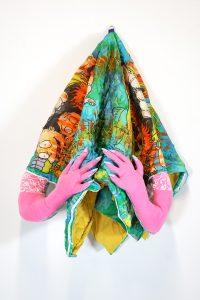
Alexander Hernandez, Hide and Seek, 2021. Sewn and spray
painted found sleeping bag, fabric remnants with acrylic nails, 188 x 42 inches. Photo by the artist.
In The Studio: Bound By Binary: Genderfluid Expression Explored through Digitally Knitted Textile Practice by Dan Collings: “Binary gender, as a design model in contemporary fashion, places limitations on gender expression… Defining clothing by binary dictates who can wear them. Gender and gender expression need room for movement, change and diversity. One binary gender simply wearing clothes associated with or expected of the other gender does not push the binary.”
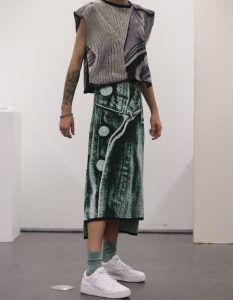
Dan Collings, Trompe L’oeil Garments, 2021. Digitally knit cotton yarn. Photo by the artist.
In Conversation: With Michael Espinoza by Kyle Herrington: “Embroidery is an act of obsessive penetration. For me, it’s a sexual act, done over and over again. I think that relates to queerness in the sense that we replicate our identities as queer people by replicating certain acts. It would be one thing if we just had one dalliance with another queer body, and that was just one thing that we did.”
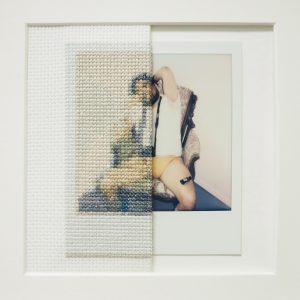
Michael Espinoza, Javi Polaroid II, 2023. Cross-stitch embroidered Polaroid 600, 5 x 5 inches. Photo by the artist.
In The Studio: Two Women and the Genealogy of a Bean by Bogil Lee: “My practice to date has focused on this versatility of knitting, and how this characteristic embodies multiple layers of time and space. I make, un-make and remake in my knitting processes. This creates a form that simultaneously lies between completion and unraveling. This approach speaks to the past and the present; the domestic and the public; societies and memories. It is multiple, plural and partial. It refuses to be located at a singular time and place.”
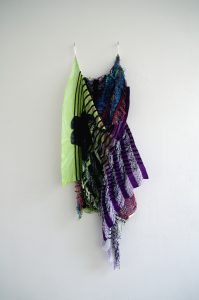
Bogil Lee, Petaus, 2023. Double-jacquard knitted cotton and polyester, dyed and sublimation printed, 41.3 x 22.8 inches. Photo by the artist.
Curatorial Perspective: Form and Formless by Alpesh Kantilal Patel: “The works of these artists concern the “in-betweeness” of identity, such as the experiential, embodied nature of viewing, the blurring of humans and the environment, the physicality of images and the materiality of film, as well as the rupturing of binaries such as cellular/planetary and the masculine/feminine. Assembling these artworks for this special issue also suggests that LGBTQIA+ identity is always and already intersectional with a range of seemingly disparate categories of identity and those that have yet to be articulated in language.”
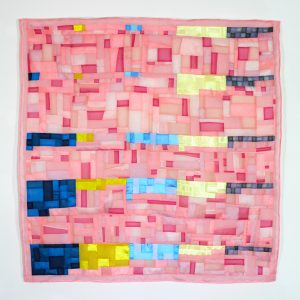
Julia Kwon, Number of Anti-LGBTQ Bills Introduced in State Legislatures in 2018–2022 (Record number of anti-LGBTQ bills were introduced in 2022, as of July 2022: most of them target transgender and nonbinary people with a particular emphasis on trans youth, including restrictions on youth athletics, curriculum restrictions, adolescent healthcare restrictions, religious or First Amendment exemptions, among others), 2022. Bojagi-sewn Korean silk, 33 x 33 inches. Photo by the artist.
In The Studio: Webs of Culture by Venancio Aragon: “Venancio Aragon Textiles are the signature artform of the Diné Nation. From humble utilitarian origins, our weavings continue to change and evolve along with our culture and identity. Weaving also serves as a vessel for the transmission of cultural, historical and ecological knowledge. My story as a Diné weaver is not one of an unbroken continuity of tradition; rather it’s a tale of revitalization and preservation of something that was nearly lost within my family.”

Venancio Aragon, In Defense of LGBTQ Existence, 2023. Wool/mohair weft, wool warp with natural and synthetic dyes, 25 x 35 inches. Photo by the artist.
In The Studio: PañuelX: Socioeconomic Cloth by Vanessa Viruet: “I often find myself straddling the border of not feeling entirely Puerto Rican, American or queer enough. My work serves as my attempt to better understand these distinctions and the intersections between them. My current artistic practice is dedicated to exploring materials and the symbolism of flags. For many, a flag represents home, heritage and pride, and it serves as a reflection of one’s cultural identity.”
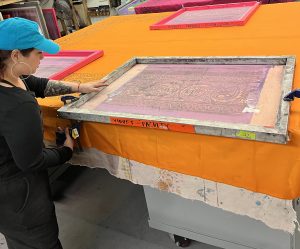
Printing Orange Bandana for installation at Comfort Station Chicago, 2023. Photo courtesy of the artist.
Informed Source: Obscuring for Clarity: The Laceworks of Pierre Fouché by matt lambert: “South African artist Pierre Fouché is a self-described appropriation artist, using images from archives and pop culture, with an aspiration to create visibility and collectivity for queer bodies in his direct community. With a desire to be a painter, Fouché found himself instead leaning into sculpture, which led to learning needlepoint, then crochet, and finally bobbin lace. He has expressed this as a logical progression.”

Pierre Fouché, ‘n Versameling Ontelbare Oomblikke (Aggregate of Countless Moments), 2022. Macramé and bobbin lace with polyester rope, 62.2 x 90.5 inches. Photo: Whatiftheworld Gallery, Cape Town.
In Conversation: A Place of Overall Softness: Char Schwall’s New Fiber Art by Anne Gatschet: “Sea Lover’s forms draw vision across learned boundaries, such as the belief we often cling to that nature is separate from human design. Viewing them, I look into the emergence of form and consider the visibility of transformation.”

Char Schwall, Sea Lover (installation), 2021. 18 sewn and appliquéd artworks, 71.5 x 148 inches. Photo: courtesy of Bruno David Gallery.
In Conversation: With Ramekon O’Arwisters by George McCalman: “His process invites viewers to see pieces of themselves in the materiality he deftly wields into sculptures, shapes and architecture. There is nothing off limits in his fine art pieces. He combines the natural elements of our everyday lives: string, twine, fabric, the things that bind, with the unnatural: plastic, tarp, polyester, the things that don’t degrade.”
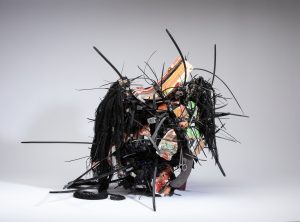
Ramekon O’Arwisters, Bitten #1, 2022. Fabric, ceramic shards, and miscellaneous materials, 26.5 x 19 x 13 inches. Photo: David Schmitz, courtesy of the artist & Patricia Sweetow Gallery.
In The Studio: For Félix (love letter – excerpt) by John Paul Morabito: “Hand-beading, the essential gesture of the work, invokes body prayer and ritualistic petitions for miracles. In the Catholic tradition, a novena is a ritual of the rosary where the prayer is performed as a plea for grace and miraculous intervention. As with any prayer of the rosary, object and gesture are tandem occurrences; the devotions are spoken and counted as faithful fingers pass the continuous circle of beads between them. Facing this devotional connection, I am performing a material novena, uttered bead by bead, through tapestries that queer the ancient Catholic prayer into a blasphemous plea for queer salvation.”

John Paul Morabito, For Félix (red and blue like a kiss you will never taste again), 2022. Cotton and glass beads, 92 x 46 inches. Photo: Tim Safranek.
This project is supported in part by the National Endowment for the Arts!
To buy a copy of Seeing / Being Seen, go to the SDA Marketplace, or you can check out a free digital sample on our SDA Journal page.
